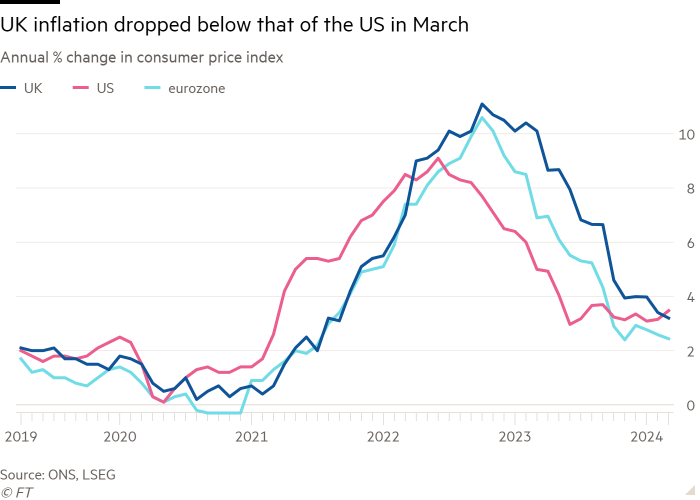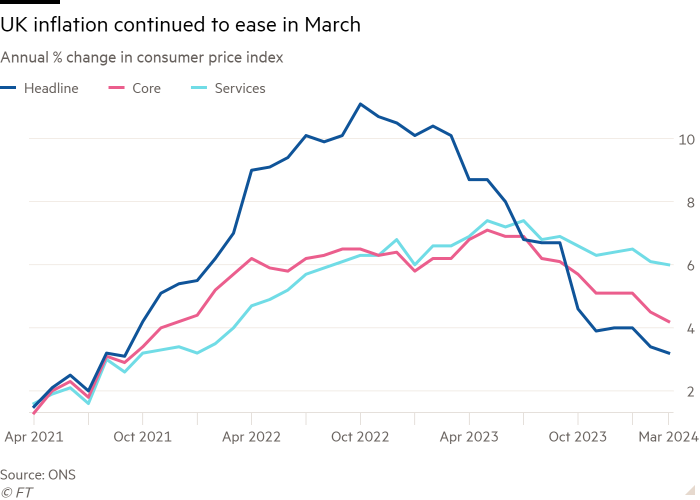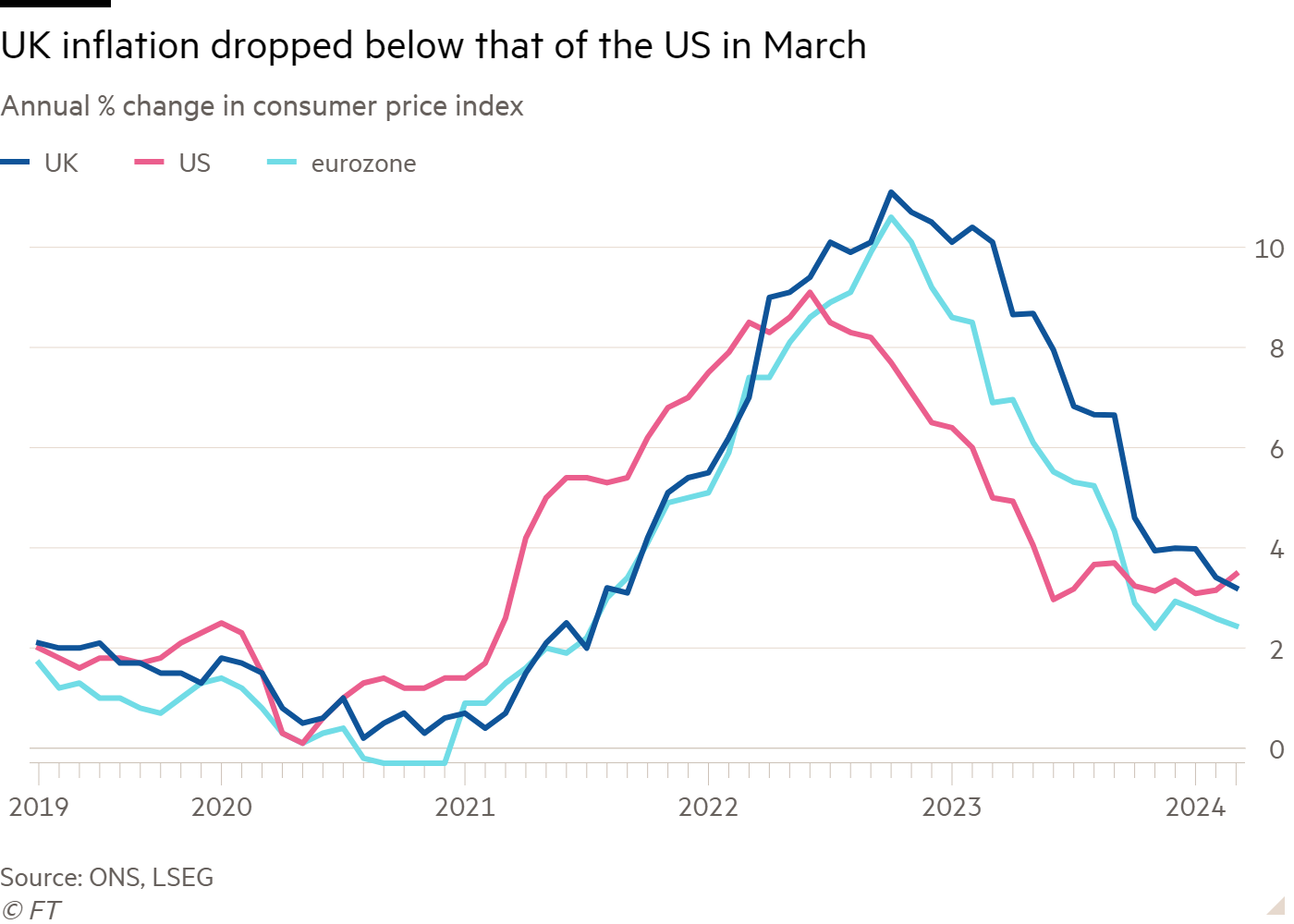Stay informed with free updates
Simply sign up to the UK inflation myFT Digest — delivered directly to your inbox.
UK inflation slowed less than expected last month, making traders and economists more cautious about the likely pace of interest rate cuts even as the reading came in below that of the US for the first time in two years.
Consumer prices rose at an annual rate of 3.2 per cent in March, down from 3.4 per cent in February, the Office for National Statistics said on Wednesday.
The figure was slightly higher than the 3.1 per cent forecast by economists polled by Reuters and the Bank of England and above the BoE’s 2 per cent target, but the lowest since 2021. Driven by a fall in food prices, it was also lower than the rate of price growth in the US for the first time since March 2022.
Core inflation, which strips out volatile energy and food prices, declined to 4.2 per cent in March from 4.5 per cent in February. Analysts had expected a decline to 4.1 per cent. Services inflation, which is closely watched by policymakers, dipped from 6.1 per cent to 6 per cent.
Simon Pittaway, senior economist at the Resolution Foundation think-tank, said the headline 3.2 per cent reading showed Britain was exiting the “prolonged period of double-digit price rises” that saw inflation peak higher in the UK than in other advanced economies.
“With UK inflation finally falling below the US, its unwanted outlier status is over,” he added.
But Ruth Gregory, economist at research company Capital Economics, cautioned that “the smaller-than-expected fall in CPI inflation raises the risk that inflation will follow the trend in the US and soon stall. The chances of interest rates being cut for the first time in June are now a bit slimmer.”

Traders in swaps markets are now betting that the BoE will begin reducing its benchmark rate from a 16-year high of 5.25 per cent in either September or November, having fully priced in a cut for September before the ONS release.
Markets are pricing in 0.38 percentage points of cuts by the end of the year, down slightly from 0.42 percentage points before the inflation figures were published.
The pound was 0.4 per cent higher against the dollar at $1.2475.
The UK data follows higher than expected inflation figures in the US, which prompted markets to slash bets on how much central banks will cut rates this year.
Economists had been closely watching services inflation as a measure of domestic price pressures. It eased only slightly to 6 per cent in March, in contrast with goods price growth, which dropped to only 0.8 per cent in March from 1.1 per cent the previous month.
Separate ONS data published on Tuesday showed annual wage growth, which heavily affects services inflation, stayed steady at 5.6 per cent in the three months to February.

Rob Wood, economist at consultancy Pantheon Macroeconomics, said the combination of “strong” wage data and “sticky underlying services inflation” would “keep the Monetary Policy Committee cautious”, adding that he predicted the first rate cut to come in August rather than June.
However, Yael Selfin, chief economist at advisory firm KPMG UK, said Wednesday’s data was “unlikely to move the needle” for the BoE.
“We expect inflation to return to target later this spring, which raises the prospect of interest rate cuts from June onwards. Fewer rate cuts by the Fed are unlikely to have a major impact given the more favourable inflation outlook and the ongoing weakness in the UK economy,” she added.
The ONS data showed that the fall in the rate of inflation last month was driven by food prices, partially offset by rising fuel prices. Food inflation slowed to 4 per cent in March from 5 per cent in February, well below the 45-year peak of 19.2 per cent in March 2023.
BoE governor Andrew Bailey said on Tuesday that inflation was falling but that timing of interest rate cuts depended on how much evidence of easing price pressures each MPC member needed.
“Our judgment with interest rates is how much do we need to see now to be confident of the [disinflation] process,” said Bailey at an event organised by the IMF in Washington. “The dynamics for inflation are rather different now, between Europe . . . and the US. I think there’s more demand-led inflation in the US than we’re seeing.”
The IMF on Tuesday said it expected UK inflation to drop from 7.3 per cent last year to 2.5 per cent in 2024 and 2 per cent next year.
The governing Conservative party has pledged to ease price pressures ahead of the general election expected this year. Chancellor Jeremy Hunt said the figures on Wednesday showed “the plan is working” and that lower inflation was “helping people’s money go further”.
But shadow chancellor Rachel Reeves said that “under the Conservatives working people are worse off”, with prices “still high”.
Read More: World News | Entertainment News | Celeb News
FT










